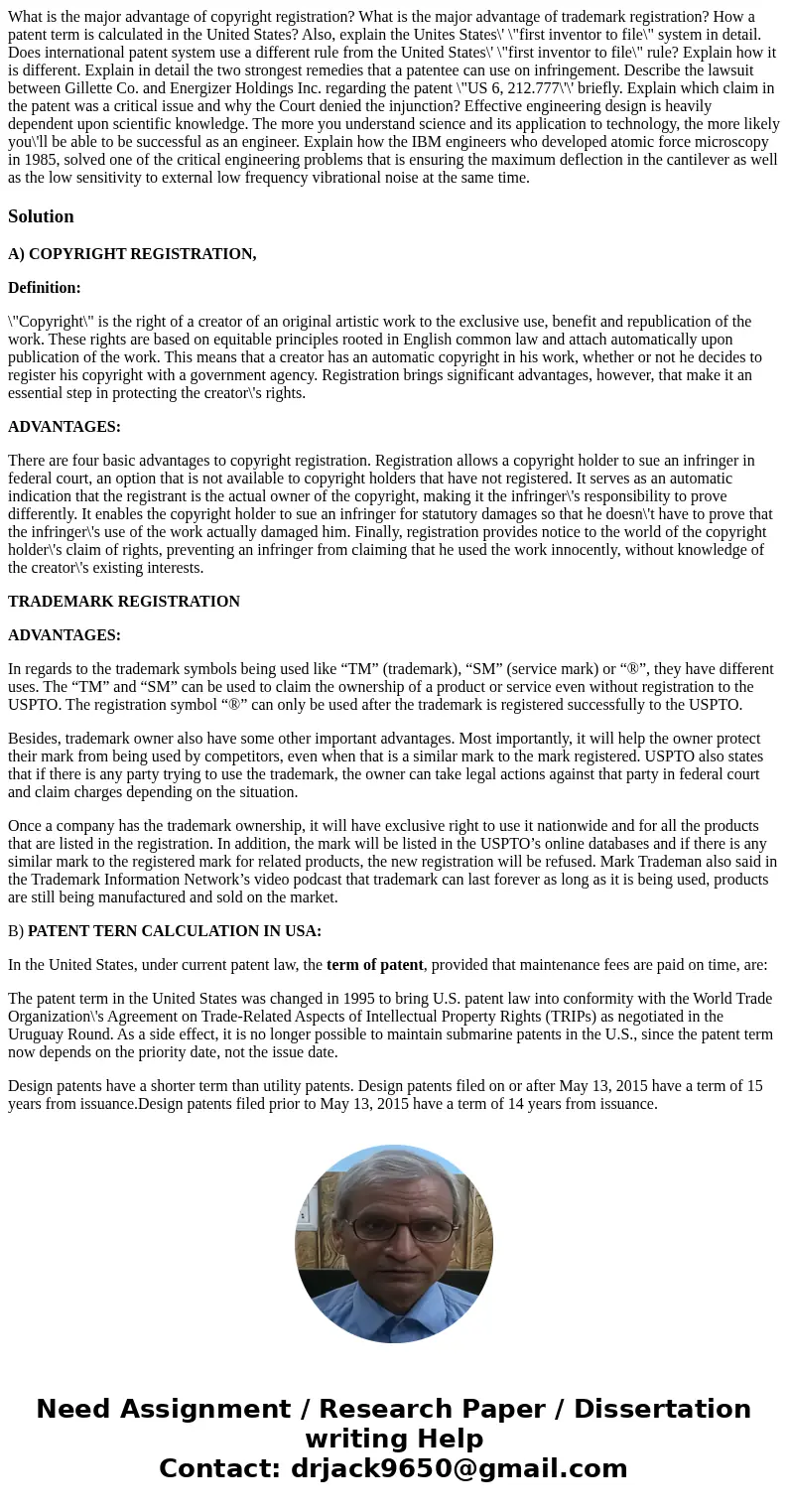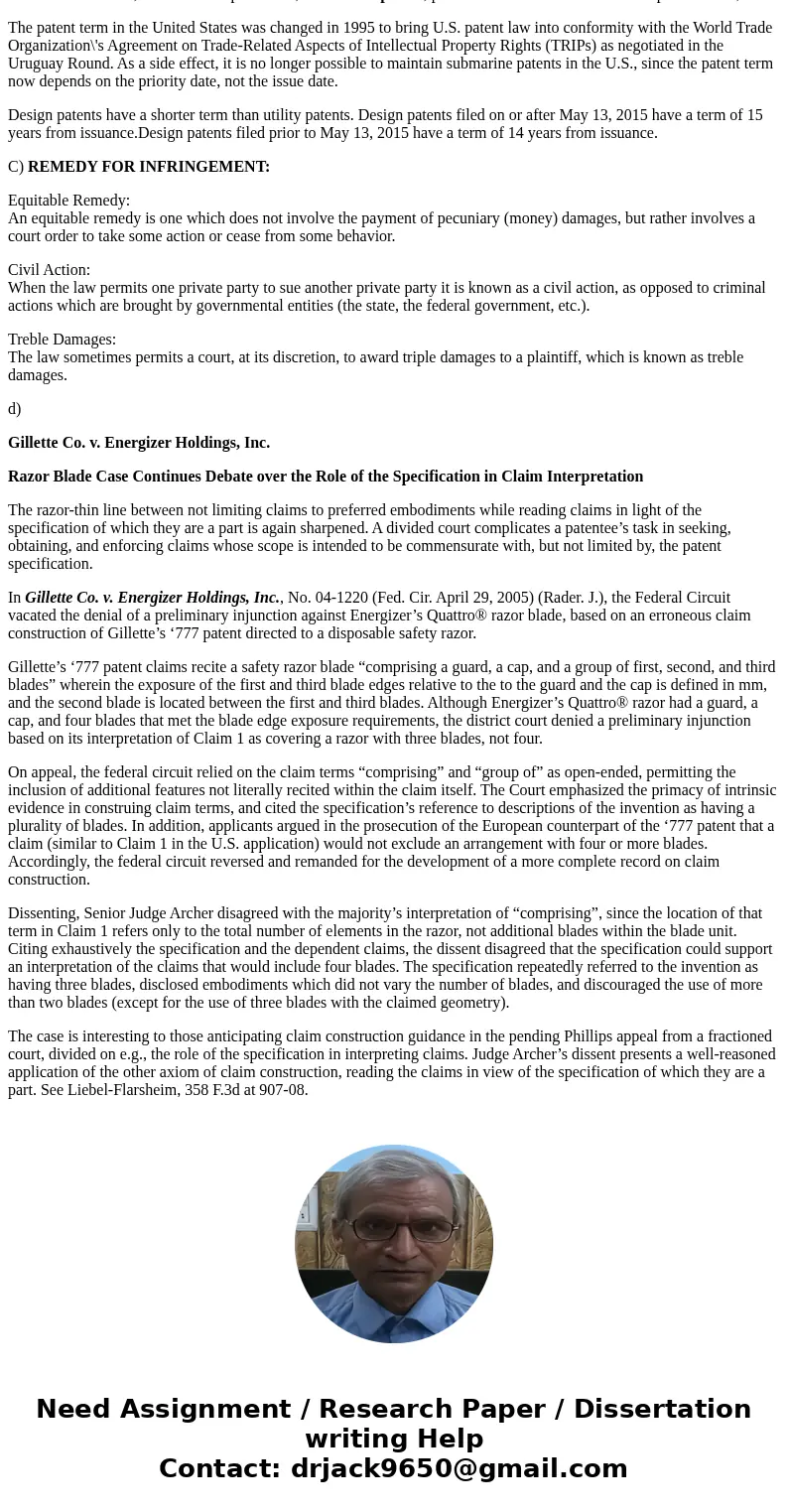What is the major advantage of copyright registration What i
Solution
A) COPYRIGHT REGISTRATION,
Definition:
\"Copyright\" is the right of a creator of an original artistic work to the exclusive use, benefit and republication of the work. These rights are based on equitable principles rooted in English common law and attach automatically upon publication of the work. This means that a creator has an automatic copyright in his work, whether or not he decides to register his copyright with a government agency. Registration brings significant advantages, however, that make it an essential step in protecting the creator\'s rights.
ADVANTAGES:
There are four basic advantages to copyright registration. Registration allows a copyright holder to sue an infringer in federal court, an option that is not available to copyright holders that have not registered. It serves as an automatic indication that the registrant is the actual owner of the copyright, making it the infringer\'s responsibility to prove differently. It enables the copyright holder to sue an infringer for statutory damages so that he doesn\'t have to prove that the infringer\'s use of the work actually damaged him. Finally, registration provides notice to the world of the copyright holder\'s claim of rights, preventing an infringer from claiming that he used the work innocently, without knowledge of the creator\'s existing interests.
TRADEMARK REGISTRATION
ADVANTAGES:
In regards to the trademark symbols being used like “TM” (trademark), “SM” (service mark) or “®”, they have different uses. The “TM” and “SM” can be used to claim the ownership of a product or service even without registration to the USPTO. The registration symbol “®” can only be used after the trademark is registered successfully to the USPTO.
Besides, trademark owner also have some other important advantages. Most importantly, it will help the owner protect their mark from being used by competitors, even when that is a similar mark to the mark registered. USPTO also states that if there is any party trying to use the trademark, the owner can take legal actions against that party in federal court and claim charges depending on the situation.
Once a company has the trademark ownership, it will have exclusive right to use it nationwide and for all the products that are listed in the registration. In addition, the mark will be listed in the USPTO’s online databases and if there is any similar mark to the registered mark for related products, the new registration will be refused. Mark Trademan also said in the Trademark Information Network’s video podcast that trademark can last forever as long as it is being used, products are still being manufactured and sold on the market.
B) PATENT TERN CALCULATION IN USA:
In the United States, under current patent law, the term of patent, provided that maintenance fees are paid on time, are:
The patent term in the United States was changed in 1995 to bring U.S. patent law into conformity with the World Trade Organization\'s Agreement on Trade-Related Aspects of Intellectual Property Rights (TRIPs) as negotiated in the Uruguay Round. As a side effect, it is no longer possible to maintain submarine patents in the U.S., since the patent term now depends on the priority date, not the issue date.
Design patents have a shorter term than utility patents. Design patents filed on or after May 13, 2015 have a term of 15 years from issuance.Design patents filed prior to May 13, 2015 have a term of 14 years from issuance.
C) REMEDY FOR INFRINGEMENT:
Equitable Remedy:
An equitable remedy is one which does not involve the payment of pecuniary (money) damages, but rather involves a court order to take some action or cease from some behavior.
Civil Action:
When the law permits one private party to sue another private party it is known as a civil action, as opposed to criminal actions which are brought by governmental entities (the state, the federal government, etc.).
Treble Damages:
The law sometimes permits a court, at its discretion, to award triple damages to a plaintiff, which is known as treble damages.
d)
Gillette Co. v. Energizer Holdings, Inc.
Razor Blade Case Continues Debate over the Role of the Specification in Claim Interpretation
The razor-thin line between not limiting claims to preferred embodiments while reading claims in light of the specification of which they are a part is again sharpened. A divided court complicates a patentee’s task in seeking, obtaining, and enforcing claims whose scope is intended to be commensurate with, but not limited by, the patent specification.
In Gillette Co. v. Energizer Holdings, Inc., No. 04-1220 (Fed. Cir. April 29, 2005) (Rader. J.), the Federal Circuit vacated the denial of a preliminary injunction against Energizer’s Quattro® razor blade, based on an erroneous claim construction of Gillette’s ‘777 patent directed to a disposable safety razor.
Gillette’s ‘777 patent claims recite a safety razor blade “comprising a guard, a cap, and a group of first, second, and third blades” wherein the exposure of the first and third blade edges relative to the to the guard and the cap is defined in mm, and the second blade is located between the first and third blades. Although Energizer’s Quattro® razor had a guard, a cap, and four blades that met the blade edge exposure requirements, the district court denied a preliminary injunction based on its interpretation of Claim 1 as covering a razor with three blades, not four.
On appeal, the federal circuit relied on the claim terms “comprising” and “group of” as open-ended, permitting the inclusion of additional features not literally recited within the claim itself. The Court emphasized the primacy of intrinsic evidence in construing claim terms, and cited the specification’s reference to descriptions of the invention as having a plurality of blades. In addition, applicants argued in the prosecution of the European counterpart of the ‘777 patent that a claim (similar to Claim 1 in the U.S. application) would not exclude an arrangement with four or more blades. Accordingly, the federal circuit reversed and remanded for the development of a more complete record on claim construction.
Dissenting, Senior Judge Archer disagreed with the majority’s interpretation of “comprising”, since the location of that term in Claim 1 refers only to the total number of elements in the razor, not additional blades within the blade unit. Citing exhaustively the specification and the dependent claims, the dissent disagreed that the specification could support an interpretation of the claims that would include four blades. The specification repeatedly referred to the invention as having three blades, disclosed embodiments which did not vary the number of blades, and discouraged the use of more than two blades (except for the use of three blades with the claimed geometry).
The case is interesting to those anticipating claim construction guidance in the pending Phillips appeal from a fractioned court, divided on e.g., the role of the specification in interpreting claims. Judge Archer’s dissent presents a well-reasoned application of the other axiom of claim construction, reading the claims in view of the specification of which they are a part. See Liebel-Flarsheim, 358 F.3d at 907-08.


 Homework Sourse
Homework Sourse